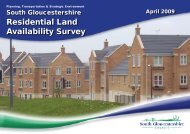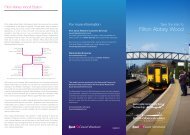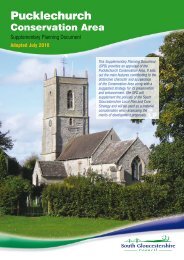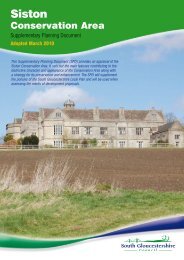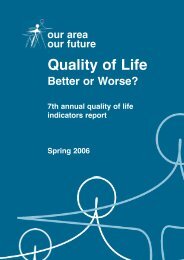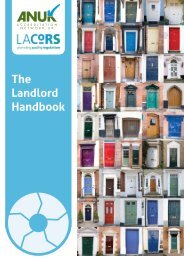Chipping Sodbury Conservation Area SPD - South Gloucestershire ...
Chipping Sodbury Conservation Area SPD - South Gloucestershire ...
Chipping Sodbury Conservation Area SPD - South Gloucestershire ...
- No tags were found...
Create successful ePaper yourself
Turn your PDF publications into a flip-book with our unique Google optimized e-Paper software.
<strong>Chipping</strong> <strong>Sodbury</strong><strong>Conservation</strong> <strong>Area</strong>Supplementary Planning DocumentFebruary 2009This Supplementary Planning Document (<strong>SPD</strong>)provides an appraisal of the <strong>Chipping</strong> <strong>Sodbury</strong><strong>Conservation</strong> <strong>Area</strong>. It sets out the main featurescontributing to the distinctive character andappearance of the <strong>Conservation</strong> <strong>Area</strong> and astrategy for its preservation and enhancement.The <strong>SPD</strong> supplements the policies of the <strong>South</strong><strong>Gloucestershire</strong> Local Plan and will be used toassess the merits of development proposals.
<strong>South</strong> <strong>Gloucestershire</strong> Supplementary Planning Document : <strong>Chipping</strong> <strong>Sodbury</strong> <strong>Conservation</strong> <strong>Area</strong>IntroductionThe medieval planned market town of <strong>Chipping</strong> <strong>Sodbury</strong> was designated as a<strong>Conservation</strong> <strong>Area</strong> on the 27th November 1975 in recognition of its special architecturaland historic character and appearance; with its exceptionally well preserved medievaltown plan, long, narrow burgage plots curving gently back from the wide bustlingmarket street; and rich variety of historic buildings. The boundary of the <strong>Conservation</strong><strong>Area</strong> is shown on the attached plan 1.In designating a <strong>Conservation</strong> <strong>Area</strong> the local planning authority has a duty to ensurethat any proposed development will preserve or enhance the special qualities of thearea.Purpose of the documentCONTENTSIntroduction p2Character AssessmentLandscape Setting p3Historic Context p4Special Features p6Enhancement Strategy p8Character <strong>Area</strong>s p9 -19The Market PlaceBurgage PlotsBrook Street,Other StreetsThe River ValleyModern DevelopmentThis guidance seeks to identify the main elements that contribute to the specialcharacter or appearance of the <strong>Conservation</strong> <strong>Area</strong> and provides a strategy for itspreservation and enhancement. It is hoped that by providing an appraisal of thebuildings, features and spaces which characterise the <strong>Conservation</strong> <strong>Area</strong>, this willhelp ensure future proposals respect the local character. The adopted documentwill supplement policy L12 in the <strong>South</strong> <strong>Gloucestershire</strong> Local Plan, and is a materialconsideration giving additional guidance when development proposals are assessed.<strong>South</strong> <strong>Gloucestershire</strong> Local Plan.This guidance should be read in conjunction with the local plan, which includesplanning polices relating to the protection of the historic environment and landscapecharacter. In particular, <strong>Conservation</strong> <strong>Area</strong> policy L12 requires development proposalsto take full account of the special architectural or visual qualities of the <strong>Conservation</strong><strong>Area</strong>. Applicants should provide an assessment to demonstrate how their proposalswill preserve or enhance the character or appearance of the area. Proposals having aharmful impact will be refused.The emphasis is on preserving and enhancing those buildings, spaces and features,which give each <strong>Conservation</strong> <strong>Area</strong> its special characterWhat Now?p20What is a <strong>Conservation</strong> <strong>Area</strong>A <strong>Conservation</strong> <strong>Area</strong> is an area of “special architectural or historic interest, thecharacter or appearance of which it is desirable to preserve or enhance”.Designation is a recognition of the group value of buildings and theirsurroundings and the need to protect, not just the individual buildings, but thedistinctive character of the area as a whole. The special character derives from acombination of many features – including trees, hedges, boundaries and walls,open spaces, groups of buildings, the degree of enclosure and coherence, aswell as the size, scale, and detailing of the buildings. Each area is unique.The Clocktower -an important focalpointPlease note: This <strong>Conservation</strong> <strong>Area</strong> appraisal sets out the main elements contributingto the character of the <strong>Conservation</strong> <strong>Area</strong> which it is felt any development should takeaccount of. It is not intended to be comprehensive and the omission of any particularbuilding, feature or space should not be taken to imply that it is of no interest.2
<strong>South</strong> <strong>Gloucestershire</strong> Supplementary Planning Document : <strong>Chipping</strong> <strong>Sodbury</strong> <strong>Conservation</strong> <strong>Area</strong><strong>Chipping</strong> <strong>Sodbury</strong> Character Assessment<strong>Chipping</strong> <strong>Sodbury</strong> has been described as a rare example of -“… a new planted town of twelfth century origin with a street plan surviving almostunaltered. It is based on a grid pattern which is paralleled by less than 30 examples ofsimilar date elsewhere in the whole country. Future planning proposals should respectthis unusual street layout.” 1Looking down onthe town - fromthe CotswoldScarp- part of theCotswold <strong>Area</strong>of OutstandingNatural Beauty.Looking down the wide main street towards the dramatic view of the Cotswold scarp in thedistance.The Landscape SettingThe small bustling market town of <strong>Chipping</strong> <strong>Sodbury</strong> is situated alongside the RiverFrome at an historic crossing point leading north to Wickwar and east to Old <strong>Sodbury</strong>.The historic core of the town is linear in form and is located on a low limestone ridgethat rises to the west separating it from the adjoining settlement of Yate. AscendingBowling Hill from the west and entering the town through Rounceval Street, theimpressive wide market street enclosed by its rich variety of historic buildings isrevealed with the splendid views of the Cotswold scarp rising in the distance.To the south and east, the historic settlement is surrounded by modern development.In contrast, the land on the north side of the River Frome and by Brook Street is lessintensively developed giving a more rural and open character enabling an appreciationof the dramatic form of the river valley. Much of this area was formerly quarried forcarboniferous limestone which supplied the building material for the historic town.However, today the open land and trees along the river and on valley sides form animportant part of the setting to the <strong>Conservation</strong> <strong>Area</strong>.1 R.Leech - from Small Medieval Towns in Avon 1974.Steep valleysides and treesby Brook Street3
<strong>South</strong> <strong>Gloucestershire</strong> Supplementary Planning Document : <strong>Chipping</strong> <strong>Sodbury</strong> <strong>Conservation</strong> <strong>Area</strong>The Historic ContextThe special character of <strong>Chipping</strong> <strong>Sodbury</strong> has been shaped by its history and itslocation on the River Frome by important trade routes. Its main stages of developmentare summarised below.In the 12th Century William Crassus, the Lord of the manor at nearby Old <strong>Sodbury</strong>,laid out a new town at <strong>Chipping</strong> <strong>Sodbury</strong>. The new town was based on a grid patterncomprising long narrow strips of property (called burgage plots) extending back fromnarrow frontages on the wide market area or pitchings of High Street and Broad Street.The burgage plots typically contained a narrow dwelling on the market frontage anda rear yard, served by a back access lane. The yard was often cultivated and usedfor the rearing of livestock. The Burghers usually carried on trades and crafts which,together with their property rights, distinguished them from the feudal peasant thuscreating a small medieval middle class. They paid an annual fixed rent to the lord ofthe manor and were free to buy and sell their burgage tenancies as they wished.Taking advantage of important trade routes between Bristol and the Cotswolds.the town provided a convenient market for local merchants specialising in wool,cloth, malt, livestock and other foodstuffs. The River Frome supplied power for thedevelopment of the cloth and weaving industries contributed to the prosperity of thetown in the 17th Century.Historically located by an important cattle drovers route - livestock were traded in themarket.As the town prospered, more specialist shops and civic buildings such as theGuildhall, banks and hotels were built. By 1727 there were 12 Coaching Inns whichplayed an important part in both social and commercial life of the town.18th Century improvements to the road network resulting from the introduction of theTurnpike system included the building of the Wickwar Road bridge. Changing uses andfashion meant many earlier buildings were altered or re-fronted producing a rich varietyof buildings and architectural styles.By the 19th Century the fortunes of the town had declined as the focus shifted to theurban areas. However, notable changes included the erection of the Clocktower in theHigh Street and alterations to the Town Hall (former Guildhall) and the Parish Church.During the 20th Century residential suburban development occurred around the edgesof the settlement with some encroachment of commercial and residential developmentinto rear burgage plots. Although quarrying has occurred since the Middle Ages thiswas greatly expanded to the north of the town at Barnhill.4
<strong>South</strong> <strong>Gloucestershire</strong> Supplementary Planning Document : <strong>Chipping</strong> <strong>Sodbury</strong> <strong>Conservation</strong> <strong>Area</strong>Circa 1880 First Edition Ordnance Survey Plan of <strong>Chipping</strong> <strong>Sodbury</strong><strong>Chipping</strong> <strong>Sodbury</strong>’s 12th Century Plan is exceptionally well preserved highlighting its nationalas well as local importance.For more on history Visit <strong>Chipping</strong> <strong>Sodbury</strong> Tourist Information Centre.5
<strong>South</strong> <strong>Gloucestershire</strong> Supplementary Planning Document : <strong>Chipping</strong> <strong>Sodbury</strong> <strong>Conservation</strong> <strong>Area</strong>Simplesymmetricalcasementwindow.The Special Features<strong>Chipping</strong> <strong>Sodbury</strong> derives its special character from a combination of elements - thelayout of the settlement; the form and detailing of buildings and their boundaries; thetreatment of roads and the spaces between buildings; the open spaces and planting.The historic town plan - <strong>Chipping</strong> <strong>Sodbury</strong>’s medieval origins in the 12thCentury as a planned settlement are still clear and rates highly amongst the smallnumber of similar planned towns dating to this time. It is the best preserved of thefour medieval towns in <strong>South</strong> <strong>Gloucestershire</strong> highlighting its national as well as localimportance. It is particularly important that new development respects its surviving formand morphology of the historic settlement.Archaeology - Due to its long history the town is a valuable source of archaeologicalinformation. Applicants will usually need to provide an archaeological assessment ofthe potential impact of their proposals.The historic buildings and structures - the town has a distinctivearchitectural character with its rich and attractive mix of traditional buildings reflectingits status as an historic market town. These range from humble vernacular cottages togrand commercial buildings in many different period styles. The 17th Century buildingswith their steeply pitched gables predominate and contrast with the simple classicalproportions of the later Georgian buildings. Many are listed as being of ‘specialarchitectural or historic interest’.The form, proportions, original materials, architectural details - windows, doors,chimney stacks, roof materials etc are all essential elements of the period character ofthese traditional buildings.There are about 150 ‘listed’ buildings & structures - including the market cross, tollpostmarker, some boundary walls & tombstones.Steeply pitchedgables addinterest to thestreet scene.Building materials - while a variety of stone is evident locally quarried rubblecarboniferous limestone predominates. Much of it would have originally beenrendered or lime-washed. For many of the grander 18th and 19th Century buildingsthe fashionable Bath limestone was used to provide formal rich detailing. Others havestucco and lined render to give the underlying rubble stone the appearance of Bathstone. Roofs, steeply pitched or partially hidden behind parapets, traditionally usenatural clay pantiles, double roman tiles or Welsh blue / grey slates. The inappropriateuse of modern materials / finishes such as reconstituted stone, cement renders andconcrete tiles has harmed the appearance of and fabric of some traditional buildingsand will be resisted.6
<strong>South</strong> <strong>Gloucestershire</strong> Supplementary Planning Document : <strong>Chipping</strong> <strong>Sodbury</strong> <strong>Conservation</strong> <strong>Area</strong>Windows - there is a wide range of windows reflecting the different periods andmix of properties. These include metal casement windows with stone mullions andleaded lights, simple wood casements, small-paned Georgian sashes and large-panedVictorian sashes. Typically windows are of painted timber and recessed behind thewall face giving depth. The appearance of some traditional buildings has been harmedby unsympathetic replacement windows and doors or by using inappropriate details,materials or finishes. Owners are encouraged to reinstate these with windows sensitiveto the period character.Boundaries - typically consist of rubble stone walls with cock and hen coping.However, Bath stone and iron railings are used for some of the grander buildings. Thewalls are essential to the character delineating property boundaries along Burgageplots and providing an attractive feature and enclosure along roads. The removal ofsections of stone walls has harmed the character and any further loss will be resisted.Owners will be encouraged to reinstate stone boundary walls and ensure any boundarytreatment is sensitive to the historic character.Diagonal glazingbar sash window.Simple wood painted fascia sign - an attractive traditional feature.Shop-fronts and signs are an important part of the building and can add to thevitality of the street scene. However, it is important that they are correctly proportionedand detailed. Where original historic shop-fronts and architectural features exist theseshould be retained along with the correct window proportions in any refurbishmentworks. Simple painted timber shop-fronts and fascia signs or the use of individualletters generally works best. The use of plastic, overlarge fascia signs, large areas ofplate glass and a clutter of signs which adversely affect the appearance of the streetwill be refused. Signs should be kept to a minimum and sensitively positioned.Streetscape and surrounding spaces - much of the special character andinterest derives from its contrasting streetscape with its variations in road width, thebends and sense of surprise as a new scene unfolds combined with the informalityand enclosure by buildings, stone walls and grass verges. Historic surfaces andstructures such as the bridges, market cross, pumps and the turnpike milestonecontribute to the distinctive character and should be preserved. Care is neededto ensure that any highway or other works respect historic street patterns andappearance using appropriate materials and avoiding a proliferation of signs, roadmarkings or street furniture –seats, bins etc which can have an adverse visual impact.Traditional stonekerbs and settsto foot-waysshould beretained. Avoiduse of concretekerbs or edging.7
<strong>South</strong> <strong>Gloucestershire</strong> Supplementary Planning Document : <strong>Chipping</strong> <strong>Sodbury</strong> <strong>Conservation</strong> <strong>Area</strong>Keeping And Enhancing The CharacterWhen considering changes - great care is needed. The cumulative impact of oftenquite small changes such as using the wrong materials, unsympathetic extensionsor alterations to shop-fronts, erosion of walls and loss of trees can harm the uniquecharacter and downgrade the area. Similarly, insensitive changes to the public realm,roads, verges and open areas can also detract from the pleasant informal characterand sense of place. Collectively, residents, businesses, landowners and local andtown councils can help to protect this unique area by ensuring any works they do aresensitive to the character. To encourage works sensitive to the character, a suggestedstrategy for the preservation and enhancement of the area – including both generaland more specific guidance is set out below and on the accompanying plan 2.You should seekto protect thecharacter in allwork – even ifconsent from theCouncil is notrequiredIf you are unsureabout the impactof your proposals– please ask a<strong>Conservation</strong>Officer for advice.Some repairs tolisted buildings mayrequire consentPreservation and Enhancement StrategyThe overall aim is to preserve and enhance the historic character and appearance ofthe <strong>Conservation</strong> <strong>Area</strong>, its historic buildings, features and their setting as follows:-1) Preserve and reinforce the historic character.By encouraging repairs and ensuring any works to both the listed and unlistedbuildings, features and surroundings are considered in relation to the historic contextand use appropriate materials, scale and detailing.2) Ensure that any new development (or alteration) respects thehistoric context.New development or alterations needs to be in scale and sympathetic to the characterand appearance of the <strong>Conservation</strong> <strong>Area</strong>. It is important that it does not adverselyharm the setting of the existing historic features, views, or archaeology.3) Minimise the impact of modern developmentBy ensuring adjoining modern development does not impinge on the historic characterand setting. Enhancement proposals should seek to reduce this impact by protectingimportant views or gaps and using planting and natural stone walls to help soften theimpact of obtrusive features and create a sense of enclosure and place.4) Preserve and reinforce the vitality of the historic market town.By ensuring alterations, new development or changes of use are appropriate andenhance its function.8
<strong>South</strong> <strong>Gloucestershire</strong> Supplementary Planning Document : <strong>Chipping</strong> <strong>Sodbury</strong> <strong>Conservation</strong> <strong>Area</strong>Character <strong>Area</strong>sThe traditional market town of <strong>Chipping</strong> <strong>Sodbury</strong> contains a number of different areaseach with their own distinctive character reflecting the various functions and usesof the settlement. Within these areas any alterations or changes thus need carefulconsideration to ensure the character is not diluted or lost by inappropriate works, Thecharacteristics of these areas are described on pages 10 -19. They include:-1) The Market Place - High Street and Broad Street.2) The Burgage plots and back lane areas.3) Brook Street.4) Other streets adjoining the market place - Horse Street, HattersLane, Rounceval Street, The Parade and Wickwar Road.5) The River Frome and the area to the north.Horse Streetcottages.6) Modern development on the settlement edge.© Copyright <strong>South</strong> <strong>Gloucestershire</strong> Council 2008. All rights reserved. © Crown Copyright. All rights reserved. 100023410, 2008.KeyThe Market Place High Street and BroadStreetThe Burgage plots and back lane areasBrook StreetThe River Frome and the area to the northOther streets adjoining the market place-Horse Street, Hatters Lane, RouncevalStreet, The Parade and Wickwar Road.Approaches and modern development onthe settlement edgewater pump inHIgh Street.9
<strong>South</strong> <strong>Gloucestershire</strong> Supplementary Planning Document : <strong>Chipping</strong> <strong>Sodbury</strong> <strong>Conservation</strong> <strong>Area</strong>1) The Market Place - High Street and Broad StreetThe busy, lively centre of <strong>Chipping</strong> <strong>Sodbury</strong> with its wide dramatic main street lined byattractive historic buildings retains many characteristics typical of a medieval markettown. Its dominant feature is the wide main street and market pitchings. Maps datingfrom mid 18th Century show market buildings erected down the centre of the street.Originally used as a cattle market (up until the 1950’s) the road narrows at each end,adjoining Rounceval Street and Horse Street, to enclose the former market place.The ModaHotel with itsgrand Georgianfaçade, is setforward of otherproperties forminga prominenttownscapefeature, closingthe upper end ofthe High StreetThe market tradition continues today with annual fairs and farmers markets.Traffic and parking has a dominating impact on the main street and pitchings.However, measures to control parking and traffic need to be sensitive to the historiccharacter as well as responsive to local residents and shoppers.Despite the considerable width of the main street, the continuous frontages of mainlythree storey historic buildings – many with the steep gabled roofs give an enclosed feeland strong sense of place. Apart from the distant vista to the Cotswold scarp viewsoutwards are restricted to small glimpses through archways and occasional views oftrees and the church tower just visible above some buildings. It is essential that anysurrounding development behind frontages or on the edges of the settlement do notimpinge on views or detract from this historic character.The market cross– provides a focalpointThere is a wide range of historic buildings. Some of the earliest are of 14th and 15thCentury date although the majority date from the 16th and 17th Century. Many werealtered and refaced in the 18th and 19th Centuries reflecting changes in fashion anduse. To maximise the number of properties along the market frontage the buildingstypically had narrow frontages and rectangular plan forms characteristic of medievalplanned settlements. Building heights vary from two, to three storeys, many withsteeply pitched gabled roofs. This results in a pleasing mix of architectural styles,detailing and variation in rooflines adding interest to the street scene. However, careis needed over alterations as even small changes, if not sympathetic, can harm theperiod character.10
<strong>South</strong> <strong>Gloucestershire</strong> Supplementary Planning Document : <strong>Chipping</strong> <strong>Sodbury</strong> <strong>Conservation</strong> <strong>Area</strong>The variety of building styles and roof lines adds interest to the street sceneReflecting its important function as a commercial centre the principal streets of thetown include a mix of houses, shops, public houses, grand public buildings andother services. These uses, along with the variety of traditional shop-fronts, signs andarchitectural detailing, contribute to the distinctive and lively bustling character of thetown. Typically shops are small units – reflecting the form of the historic buildings andmany are managed by independent local retailers adding to the unique sense of place.It is important to retain the character and form of buildings by avoiding unsympatheticsigns, alterations to shop-fronts or the amalgamation of shop units.Maintaining the viability and attractiveness of the town to shoppers and visitors andusage of the historic buildings is important. Proposals to change the use of shops, orfor new retail development on the edge of the town will need to be carefully consideredto ensure such changes do not harm the vitality of the town and the use of its historicbuildings.Simple hangingsigns on metalbrackets are atraditional featurePreservation and Enhancement StrategyEnsure any development behind frontages or on the edges of the settlement donot impinge on views or detract from the historic character.Retain architectural and historic character and ensure any repairs, extensions oralterations are sympathetic.Shopfronts and signs need to be sensitive in terms of scale, design, materials,postion, number, colour and detailing. Resist the amalgamation of units.Ensure traffic management measures, street furniture and highway works areappropriate and sensitive to the historic character.New large scale retail / commercial development proposals within or adjacentto the town centre should be subject to an independent retail assessment toascertain the impact of the scheme on the viability and vitality of the historiccentre and its traditional shops.Seek to reduce the adverse impact of traffic and parking on the historic town.A Transport Assessment will be required for development having significanttransport implications.Clutter of signsand posters isharmfull to thecharacter11
<strong>South</strong> <strong>Gloucestershire</strong> Supplementary Planning Document : <strong>Chipping</strong> <strong>Sodbury</strong> <strong>Conservation</strong> <strong>Area</strong>The archways tothe rear plots giveglimpses out fromthe main streetwhich contributeto a sense ofmystery.2) The Burgage Plots and back lanes.Running behind the buildings fronting the wide main street are long narrow propertystrips – burgage plots. Typically defined by stone boundary walls, these plots wereused for cultivation and the rearing of animals; and for storage and small -scaleindustrial and commercial activities associated with the market town. The plots usuallycontain a number of generally small- scale outbuildings with a lane providing accessto the rear of the plots. Waste was usually disposed in pits dug into the garden so thearea has potential as a rich source of archaeological information.Today the survival of the deep burgage plots running back from the frontage propertiesis an important part of the character of the settlement. However, the introduction oflarge scale development and unsympathetic uses, car parks and the amalgamationof individual plots has resulted in the partial loss of the historic town layout. Retainingthe remaining burgage plots is therefore particularly important and proposals toamalgamate plots or split parts of the plots for development are unlikely to beacceptable.The stone walls to the Burgage Plots and rear lane are an important characteristicLargely hidden from the main street, views are restricted to occasional glimpses fromthe main street, and from narrow side lanes such as Hounds Lane and HorseshoeLane and the informal rear paths. In contrast with the more urban and built upcharacter of the main street frontage the rear burgage plots generally have a quietercharacter and softer green feel provided by gardens, trees and planting giving anattractive setting to the traditional buildings.The main frontage property is generally characterised by a less formal rear elevation.Many have been extended over time as more space was required. Typically theseextensions are domestic scale and subservient to the main property resulting in avariety of roof profiles producing an interesting informal mix.Glimpse to rearburgage plot.12
<strong>South</strong> <strong>Gloucestershire</strong> Supplementary Planning Document : <strong>Chipping</strong> <strong>Sodbury</strong> <strong>Conservation</strong> <strong>Area</strong>The narrow Hounds Lane and range of narrow outbuildings within burgage plotWithin some plots are individual outbuildings or long rows of narrow small scalebuildings single (or sometimes one and a half) storeys high and constructed of stoneand usually incorporating one of the stone boundary walls to the plot. They havea distinctive character reflecting their historic use for storage or other commercialactivities connected with the market. It is important to keep these traditional buildingsallowing appropriate uses whilst ensuring the form and character is not harmed.Archway to rearof burgage plotwith its range ofbuildings.Preservation and Enhancement StrategyProtect the original plan form of the settlement. Retain the long narrow characterof the plots by resisting the amalgamation or division of plots or their separationfrom the historic frontage property.Retain gardens and open spaces which contribute to setting of the historicproperties and resist new development or uses harmful to the character andsetting.Seek to reduce the impact of existing unsympathetic development or uses andrequire any new development to respect and enhance.Retain historic stone outbuildings and encourage their repair and sensitive use.Ensure any alterations are appropriate and sympathetic to the character of thebuilding and its surroundings.Retain, repair and reinstate historic stone boundary walls which delineate theburgage plots and rear lanes. Avoid the use of fencing which is harmful to thecharacter.Extensions to rear of existing properties should be subservient and sympatheticwith the property. Extensions / development within plots should be small scaleand should not extend full width of the narrow plot.Retain the informal, enclosed character of the narrow lanes. Resist the creationof new vehicular access to properties or other alterations where this would harmthe character or undeveloped appearance.The narrow rearlane enclosedby stone wallsand planting13
<strong>South</strong> <strong>Gloucestershire</strong> Supplementary Planning Document : <strong>Chipping</strong> <strong>Sodbury</strong> <strong>Conservation</strong> <strong>Area</strong>3) Brook StreetHalfway up thevalley side to thenorth of the riverthe terrace ofstone cottages,formerly occupiedby quarry workersis prominent inviewsAway from the busy main street this area has a more relaxed and informal villagecharacter with a jumble of small traditional stone cottages set along the narrow windingroad and stepped paths which slope down to the river crossing. Some of the buildingsare set on, or at right angles to, the road frontage but others are set back with smallgardens enclosed by stone boundary walls. The trees, planting, grass verges, openspaces and landform of the valley sides give this area a green and rural character incontrast to the more built up feel of the rest of the settlement. The planting to the northand west around quarry works are essential to screening the quarry and retaining themore rural outlook.Constructed in the local vernacular style the stone cottages (some with render) aresmall scale, typically with narrow gables and generally of 1 and a half to 2 storeys.They have simple proportions and detailing with timber painted side hung casementsor sash windows. The roofs, of clay tiles or slates, are generally steeply pitched andwith their chimneys are important features in views looking down and across the valley.Some cottages have lost boundary walls or had unsympathetic alterations, such asreplacement windows or overlarge extensions. This demonstrates how fragile thehistoric character can be if insufficient care is exercised over such changes.The small scale size and ad hoc arrangement of cottages gives an informal village character.Preservation and Enhancement StrategyProposals should respect the small cottage character. Poorly designed andlarge scale extensions will be refused consent.Seek the retention and reinstatement of traditional details, windows, doors.Chimneys and stone boundary walls etc in a sympathetic manner.Maintain enclosure to the road by resisting the loss of stone walls or thewidening or formation of new accesses.The narrowstepped pathand stone wallscontribute to thecharacterProtect important views and resist the loss of trees, green or open space andinformal verges which contribute to the character and setting.Care is needed to ensure the verges and grassed areas maintain their informalcharacter. Avoid the use of kerbs and road markings which give an urbancharacter.14
<strong>South</strong> <strong>Gloucestershire</strong> Supplementary Planning Document : <strong>Chipping</strong> <strong>Sodbury</strong> <strong>Conservation</strong> <strong>Area</strong>4) Other Streets adjoining the market placeLeading from the wide market place are the narrower roads of Hatters Lane,Horse Street, Wickwar Road, Rounceval Street and The Parade. These roads areless commercial in character with more residential properties. They are importantapproaches to the settlement and care is needed to ensure street works, signs andadjoining development do not detract from the ‘entrances’ and setting to the town.Horse StreetAt the lower end of Broad Street by the market cross, the road takes a sharp right turninto Horse Street enclosing the market place. In contrast to the wide main street thereduced road width and tall buildings alongside combined with another sharp left turnin the road gives a strong sense of enclosure. Many of these buildings have attractivearchitectural details. Moving along the road the character changes as the scale andintensity of development reduces and commercial development gives way to smallerhouses and cottages. A small number of gardens occur which are important to thesetting of the adjoining cottages as well as the character of the street and should bekept undeveloped.House and pumpin Horse StreetOriginally opened in the early 18th Century as a turnpike road out of the town to theeast it became an important route for travellers and cattle drovers. A turnpike milestonecan still be seen today indicating the distance to Hyde Park Corner in London. Grassverges to the road edge are also important to the local character and help mark thistransition from urban to rural. The verges need to be preserved. Where hard surfacingand parking have completely taken over, this has detracted from the buildings andquality of the streetscape.Preservation & Enhancement StrategyRetain gardens, verges, trees and planting which provide an attractive setting tobuildings and street scene.Resist loss and seek to reinstate grass areas now used for parking.Maintain street furniture – pump, historic signs.The attractive group of Georgian terracehouses by the bend close off the view.The tall buildings alongside the narrow roadgive a strong sense of enclosure.Turnpikemilestone15
<strong>South</strong> <strong>Gloucestershire</strong> Supplementary Planning Document : <strong>Chipping</strong> <strong>Sodbury</strong> <strong>Conservation</strong> <strong>Area</strong>Rounceval Street and The ParadeRouncevalStreet .Situated at the upper end of the market place, this is the most dramatic entranceas views of the historic town gradually unfold. Characterised by mainly residentialproperties interspersed with some commercial uses it includes a mix of small scaleand some larger grander buildings – many formerly used as pubs, hotels and banks.It has a more genteel character and open feel with some buildings set back fromthe road with small gardens to the front enclosed by stone boundary walls or ironrailings. The Parade is situated on a high ridge and its properties are separated fromthe bustle of main road by a high stone retaining wall. The area contains a number ofmature trees within the grounds of properties which give an attractive green characterand are prominent above the buildings in Rounceval Street. The trees close to thejunction of Culverhill Road help demarcate the edge of the town at the top of hill andin combination with those to the north help filter views of modern development to thewest.Preservation and Enhancement StrategyRetain trees and verges on approachesHatters LaneNarrow,enclosed HattersLaneNamed after the hat and weaving trade, this was the site of a ford crossing the riverand the original route eastwards out of the town. Today it comprises mainly traditionalsmall domestic scale cottages set along a very narrow winding lane. Most of theproperties are set onto the road but a few have small gardens enclosed by stoneboundary walls. The gardens provide an attractive setting to the cottages. A notablebuilding is Tudor House with its jettied and timber framed upper floor projectingforward into the lane. Originally the house of a Master Weaver it is one of the oldestin the town dating from the 14th Century. To the rear, within the former burgage plot, arow of traditional buildings form an attractive group marred by the unattractive car-parkand wide entrance resulting in a loss of enclosure to the lane.On the edge of the <strong>Conservation</strong> <strong>Area</strong>, the modern industrial development, signs,aerials, expanse of car parks and lack of enclosure to the lane detracts from thehistoric character and setting. Enhancements and new more sympathetic developmentand boundary treatment should be encouraged to improve this entrance to the town.Preservation & Enhancement StrategySeek to retain and reinstate enclosure to the lane.Seek to reduce the adverse impact of adjacent poor quality development anduses with environmental improvements and new more appropriate development.Tudor Housedating from14th centurywas altered in1530 and in 17thCentury.16
<strong>South</strong> <strong>Gloucestershire</strong> Supplementary Planning Document : <strong>Chipping</strong> <strong>Sodbury</strong> <strong>Conservation</strong> <strong>Area</strong>Wickwar RoadOriginally a short lane to the church, in the 18th Century this became one of the mainroads into the town with the turnpiking of the road from the north and the constructionof a bridge over the river. To accommodate increasing industrial traffic the road waswidened in the 20th Century resulting in the demolition of a property and loss of aburgage plot on the east side of the road. The church and tower dominates views andalong with the bridge, stone walls, river and trees contribute to the distinctive character.The trees by the Cemetery and quarry help to enhance the approach from the northhowever, more recent housing development, the ATS site with its signs and trafficmanagement measures have generally detracted from the setting introducing a moreurban feel.The Parish Church of St John the Baptist, dating from the 13th Century is set in anattractive secluded position alongside the river and surrounded by mature trees. It isa later addition to the planned medieval town and is slightly unusual as it was locatedaway from the main street. Originally, a small chapel it was expanded as the townprospered funded by the weaving trade. Its tall tower is a prominent landmark visible inviews from various locations. It is important to retain the dominance of the church andits tower and to ensure any development does not detract from its setting.The ParishChurch of St.John the Baptistis listed Grade 1and with its talltower provides afocus for manyviews in andaround <strong>Chipping</strong><strong>Sodbury</strong>.The church has a dominating impact whilst the trees enhance the setting.Preservation and Enhancement StrategyRetain dominance of the church and tower. Resist development of aerialsor other buildings / structures which would detract from the setting andprominence of the church.Seek to reduce the impact of modern development with better boundarytreatment and planting.Secure enhancements and more sympathetic signage to the ATS site orencourage a more sensitive use.17
<strong>South</strong> <strong>Gloucestershire</strong> Supplementary Planning Document : <strong>Chipping</strong> <strong>Sodbury</strong> <strong>Conservation</strong> <strong>Area</strong>View of churchfrom the carpark5) The River Frome and area to the north.The River Frome marks the northern boundary of the historic town and was animportant source of water and power for the town residents and industry with a numberof mills and mill race. Today it is a quiet backwater spanned by stone bridges at BrookStreet (the original route to the north) and the Wickwar Road. Alongside the river is theFrome Valley walkway an important recreational route.Sloping down to the river, the gardens to the burgage plots on the north side of theHigh Street form part of the attractive setting to the church and River Frome, with aconcentration of mature trees along the river. The Frome walkway forms part of the rearaccess to burgage plots which are enclosed by high stone boundary walls. The pathhas a quiet, secluded and informal character. Open land to the north of the river allowsviews to the church and the streamside vegetation.Rear gardens and plots to properties form important part of setting to river and churchThe burgage plots bordering the river on the north side of Broad Street and HattersLane are predominantly gardens. A number of developments close to the river suchas the ATS garage and town hall car park have a detrimental visual impact on the riverand views. Trees within the garden areas and along the river are important in filteringviews of the more intensive uses.To the north of the riverThe land rising up from the river makes an important contribution to the setting of thehistoric settlement and <strong>Conservation</strong> <strong>Area</strong>.Brook Streetthegrassverges,adjacent trees& open landcontribute tothe landscapecharacterBetween Brook Street and the car-park the area comprises open land, field and groupsof mature trees that border the north side of the River. This land provides an attractivesetting for the Frome walkway and contributes to the rural character of Brook Streetwith the trees screening the car park.The public car park which has been expanded westwards provides valuable parkingfor the town centre. It allows some views across to the church but has an increasinglyurban character in views from Wickwar Road and the Frome Valley Walkway. Theriverside trees are essential in limiting the impact of the car park on the setting of thechurch and by the river.18
<strong>South</strong> <strong>Gloucestershire</strong> Supplementary Planning Document : <strong>Chipping</strong> <strong>Sodbury</strong> <strong>Conservation</strong> <strong>Area</strong>Adjoining to the west and north on the skyline, just outside the <strong>Conservation</strong> <strong>Area</strong>,are the woods at Ridgewood, the open grassland and trees of the former quarry andcemetery which all contribute to the setting.To the east of Wickwar Road, the Frome Walkway continues along the public openspace adjoining the river. This attractive open space with groups of trees is just outsidethe <strong>Conservation</strong> <strong>Area</strong> but makes an important contribution to its setting. It has anopen character allowing views to the river, the church and trees along the edge of the<strong>Conservation</strong> <strong>Area</strong>. Modern housing on rising land to the north would benefit from thesoftening impact of additional planting.Preservation and Enhancement StrategyRetain informal rural character and ecological value of the River Frome andwalkway, by preserving riverside trees, planting and open spaces whichcontribute to the setting to river and Frome walkway.Seek to ensure that development, uses and other changes do not exacerbateflood risk to the historic settlement.Seek to minimise impact of existing harmful development / usesPleasant views ofthe River Fromeare gained fromthe Frome ValleyWalkway6) Modern Development on the settlementedge.Once set within a rural hinterland much of the land adjoining the town is nowcharacterised by modern development. The form, scale and design of somedevelopment and uses have not respected the character or appearance of the historictown detracting from the setting and views in and out of the <strong>Conservation</strong> <strong>Area</strong>. Inconsidering proposals, care is needed to ensure the identity of the historic town andparticularly those areas on the edge of the historic core and on approaches to thesettlement are not harmed by insensitive development or uses.Existing stone boundary walls, trees and planting lessens the visual impact of someunsympathetic development and should be retained. Encouragement will be givento securing further enhancement measures or new uses which will have a beneficialimpact on the <strong>Conservation</strong> <strong>Area</strong> and its setting.Preservation and Enhancement StrategyProposals should not harm views or the setting of the <strong>Conservation</strong> <strong>Area</strong>.Seek enhancements to the “entrances” / approaches to the town.Protect existing trees, vegetation, stone walls and spaces that contribute to thecharacter. Encourage sympathetic management and appropriate new planting.Secure new more appropriate uses or enhancements such as boundary orlandscaping improvements or other mitigating measures to minimise the adverseimpact of existing unsympathetic development and uses.Attractive settingprovided by openspace to east ofWickwar Road19
<strong>South</strong> <strong>Gloucestershire</strong> Supplementary Planning Document : <strong>Chipping</strong> <strong>Sodbury</strong> <strong>Conservation</strong> <strong>Area</strong>How to contactusIf you have anyqueries or suggestions<strong>Conservation</strong> <strong>Area</strong>OfficerNatural and BuiltEnvironment TeamPlanning andEnvironment Section<strong>South</strong> <strong>Gloucestershire</strong>CouncilCivic CentreHigh StreetKingswood<strong>South</strong> <strong>Gloucestershire</strong>BS15 9TRTelephone:01454 863579Email: <strong>Conservation</strong>@southglos.gov.ukFurther information fromwww.southglos.gov.uk/<strong>Conservation</strong><strong>Area</strong>sPreserve local details and features which make an important contribution to the local characterWhat Happens Now?This document was adopted as a Supplementary Planning Document on the 23rdFebruary 2009. It will be taken into account when assessing the merits of planningapplications and other proposals in the area. Applicants will need to provide anassessment of the character to demonstrate how their proposals will preserve orenhance the character or appearance of the area. Those proposals, failing to give dueweight to the guidance in this <strong>SPD</strong>, which have a harmful impact will be refused.In preparing the document the views of the local residents, businesses and otherinterested parties were sought. Consultation on the draft document and enhancementstrategy took place in August and September 2008 by way of an advertisment,publication on the council's website and circulation of the leaflet within the conservationarea. Comments and proposed amendments to the document were subsequentlyreported to the Executive Councillor prior to adoption. (For details see Statement onConsultation Report - available from the Council).The Council is keen to work with the local community to help preserve and enhancethis special area. The strategy sets out ways we can help to achieve this. If you wishto help or have further suggestions - please let us know.www.southglos.gov.ukThis information can be made available in other languages,in large print, Braille or on audio tape.Please phone 01454 868004 if you need any of these orany other help to access Council services.Designed by <strong>South</strong> <strong>Gloucestershire</strong> Council Design & Print Services · 4334/11/08 · Tel:01454 863763 · Printed by <strong>South</strong> <strong>Gloucestershire</strong> Print on recycled paper 75% Post Consumer Waste · June 200820
7Tanks32111333129111632362124213762459282 72215El Sub Sta62814514740Bank502610541519427311022121614861022135792114316302422a1059101526264586213Plan 1 <strong>Chipping</strong> <strong>Sodbury</strong> <strong>Conservation</strong> <strong>Area</strong><strong>Chipping</strong> <strong>Sodbury</strong> was designated as a <strong>Conservation</strong> <strong>Area</strong> on 27th November 1975TankElSub StaTankWorksLYA/73HopperWorksConveyorConveyorHopperEl Sub StaBarnhill Quarry(disused)TankTanksBarnhill Quarry(disused)Stone95.7mBurial GroundBurialGroundDrainLychGateSinks72 685654 5012COUZENS CLOSE1880162648ROSS CLOSE86Key Local Plan PoliciesIn addition to the Local Plan policy (L12) relating to the preservation and enhancement of<strong>Conservation</strong> <strong>Area</strong>s a number of other policies will be relevant in the assessment of proposals.These seek to encourage good design; the protection of historic buildings, local distinctivenessand landscape character; trees; river valley and the vitality of the town centre. For full detailsof relevant policies refer to <strong>South</strong> <strong>Gloucestershire</strong> Local Plan/ LDF. available online atEl Sub Stawww.southglos.gov.uk78471036ROSS CLOSE16384540282<strong>Conservation</strong> <strong>Area</strong> (Policy L12)2725Listed Buildings (Policy L13, L14) (Curtilage listed buildings not shown)299088 86841113COUZENS CLOSE9 11 15Locally Listed Buildings (Policy 15)102130106106a21Public Footpaths/recreation route (Policy LC12)2119172912212015131121141161181262511023146106c148134106b15215417416220818419419620620221431Sinks15114916115312169173COUZENSRetail premises- changes of use (Policy RT9, RT10)Open Spaces to be protected (Policy L5, L12)- only main areas shown.(All areas will be assessed under L5, L12 when considering proposals).Existing defined settlement boundary / urban area (Policy H2)COUZENS CLOSEC0UZENS CLOSE131125127Frome Valley Walkway13711310943CLOSE87River Frome455389799777HATTERS' LANE93.4m1443Brookfield126El Sub Sta70159BROOKFIELD CLOSE72746876601858623456193233355052482942MANOR WAY272224162125WorksHopperClub397880474533River FromeElSub StaPosts66 60Frome Valley Walkway545248BARNHILL ROADCar Park91.7mPC30ROSS CLOSE24283670524842Frome Valley WalkwayDepot1 2 34WorksAvonHouse57 59HATTERS' LANE8284Vayre House71143WICKWAR ROAD8Mill7FBStone41BROOK STREETChandlersCottage384030LSO/13Frome Valley WalkwayMillbrookRiver FromeSMBM 91.00mEl Sub Sta92.0mDrainLSO/10FB3143117<strong>Chipping</strong> EdgeEstate91BATTEN COURTFootbridgePond18QUARRY ROADEl Sub StaCouncil Offices(<strong>South</strong> <strong>Gloucestershire</strong> Council)BOWLING HILLBowling Hill Business Park321 to 626ElSubStaLSO/15The HeathersNursingHomeThe Grange16ROUNCEVALMill Lane1512a14LSO/14ATHE1210PARADESTREET334The New CoachHouse3 256 52 50 48 461a37LSO/143736391 3527 2941 4332PH4947516057 61 63 6564HotelGarageROUNCEVAL STREETBROOK6668STREET6770QuakersMeetHotel21The FriendsMeeting House11a1191310123419 21 21a1423a2523 23cbHIGH STREETPCClock TowerSt John theBaptist's Church41Tourist Information CentreLibrary43TheCottage45St.John's Church Centre47TroughOstlers CottageDepot51Pump51aWks53Town Hall61PH70 626466PHCatholic ChurchPHSt LawrencePresby73a73BankPH8571 75 77BROAD STREET7984Hall8381WarMemorial3595.5m121229Hotel32111PO7Tudor HouseClubHATTERS' LANEEl Sub StaBeaufortMews1233MELBOURNE DRIVE60564036542454648T T Trading EstateMastTank5759151412VauxhallHouse16 231ROGERS COURTMELBOURNE4201DRIVEEl Sub Sta4142El Sub Sta104C4B335361333452526224FROME ROAD6131 310Posts315215CHESTNUT DRIVEELM CLOSE1422aHigh Trees102.0m2422 2016LEAMANKynance House5StoneHouseMews2OaPolice StationCotswoldHouseSchoolOld GrammerChurchBurial Ground1 to 30Cotswold CourtHallARNOLD COURT18 16HORSE STREETMelbourne MewsCottage41MS4547345130AbbeyfieldHouse495353a43MELBOURNE DRIVE55575941a41b41611925MELBOURNE DRIVE17LSO/2114ChestnutPoundGORLANDS ROAD3234HORSESHOE LANECULVERHILL ROADHOUNDS ROAD1 7CLOSE55LSO/16El Sub Sta34485056 545860Pump64 62666869 7779PH81MEADOW ROADHIGHFIELD9ROADLB14481101418CULVERHILLROAD21VicarageSt John'sC of E Primary SchoolDrainFB1HOUNDS CLOSE1522HallHall14LSO/1974TCBMEAD ROADHORSE STREET7616 1086 80519 2117El Sub Sta22HollyHouseChy16CHIPPING SODBURY18MountainAshRoseAcreEl Sub Sta353736WOODMANS CLOSEVIRGINIA CLOSE7GRASSINGTON DRIVE© Copyright <strong>South</strong> <strong>Gloucestershire</strong> Council 2008. All rights reserved.34This map is reproduced from Ordnance Survey material with the permission of Ordnance Survey on behalf of the Controller of Her Majesty's Stationery Office© Crown Copyright. Unauthorised reproduction infringes Crown Copyright and may lead to prosecution or civil proceedings. 100023410, 2008.Homefield HouseCross WaysCULVERHILLROADho33Posts5048 46 44AWOODMANS44 42A424040A38A6MEAD ROAD90
724 147Tanks3211133312911163235621213762459282 7297215El Sub Sta62814514740Bank502610541519427311022121614861022135792114316302422a10559101526323464586213E AVENUE45JUBILEE GARDENSPlan 2Preservation & Enhancement Strategy15following features/elements and their settings4515551a5312 1311 11a108Encourage appropriate management, protection and enhancement of theElSub Sta3<strong>Conservation</strong> <strong>Area</strong>MELROSE CLOSE19Historic Buildings and StructuresLocally Listed BuildingsLandmark/prominent buildingsWoodlands and important treesRiverPublic FootpathsBarnhill Quarry(disused)WICKWAR ROAD100.1mStoneStone95.7mClub HouseDrainFootball PitchMillenniumGardenSinksScoutHutAEPlaygroundk16WWW2648Cricket GroundViews1Seek enhancements, improvements to boundary treatment/more sympathetic uses2CAROLINE CLOSE10El Sub Sta132Main areas of open space, verges and gardens 27 which contribute to landscape25character (only larger areas shown- other areas 29 also contribute to character)366384029088 8684PavilionMaintain enclosure Pavilion to roads. Ensure any traffic management measures,works or street furniture respects the historic characterTennis CourtsSeek to reduce the impact of unsympathetic modern development onformer burgage plots/settlement edgeProtect views of valley and skyline. Ensure any adjoining development doesDOWDING CLOSEnot encroach/detract from viewsST JOHNS WAYEnhance car park and retain parking use for shoppers/visitors to the town.COUZENS CLOSE1121141161189 11 15110102106106a106c106b21174118431Sinks1211COUZENSEncourage sympathetic management and appropriate new planting.13113743455393.4m144MastBrookfieldHORTON ROADEncourage appropriate enhancements and improvrments to boundary treatment with planting or stone walls.CLOSEHATTERS' LANE6159BROOKFIELD CLOSE18193222241621149125127151River Frome87897977TankElSub StaTankWorksWorksRIDGEWOODretain woodlandsetting.HopperWorksConveyorConveyorHopperAEHopperEl Sub StaAEClubBarnhill Quarry(disused)TankTanksBarnhill Quarry(disused)Maintain trees & greensetting to CABurial GroundBurialGroundLychGate5654 5012COUZENS CLOSE72 6818ROSS80ROSS CLOSE8678ROSS CLOSE471458239112119172912212015131262523146130134152154148COUZENS CLOSE162208206202 196 194C0UZENS CLOSE214153161169173109113Frome Valley Walkway9712El Sub Sta7078807274687660586256474533355052482942MANOR WAY272533MillRiver Frome7ElSub StaFBPostsStone66 60Frome Valley Walkway54524148ChandlersCottage384030Frome Valley WalkwayMillbrookBARNHILL ROADCar kParkRiver Frome91.7mPCWICKWAR ROADSMBM 91.00m3092.0m24El Sub Sta2836705248Drain42FBFrome Valley Walkway3143Depot1 2 384117<strong>Chipping</strong> EdgeEstate9WorksAvonHouse57 59HATTERS' LANE182847BATTEN COURT1143FootbridgePond18El Sub StaCouncil Offices(<strong>South</strong> <strong>Gloucestershire</strong> Council)95510PostsBowling Hill Business Park332152151 to 62617The HeathersNursingHome1 7The Grange41435371612a21536142a33The New CoachHouse3 21a373736391 3527 2941 434947516057 61 63 65Cross Ways© Crown Copyright. Unauthorised reproduction infringes Crown Copyright and may lead to prosecution or civil proceedings. 100023410, 2008.7LB1419 21ElSubStaEl Sub StaSTREETMill LaneBROOK STREETCLOSEWWWWWWWWWWWWWWWWWWWWWMaintain stonewalls &enclosure Vayre toHouselaneQUARRY ROADVIRGINIA CLOSEBOWLING HILLMEADOW ROADHIGHFIELDROADCHESTNUT DRIVEGRASSINGTON DRIVEELM CLOSEROUNCEVALTHE341210PARADEHigh Trees© Copyright <strong>South</strong> <strong>Gloucestershire</strong> Council 2008. All rights reserved.8102.0m14CULVERHILL ROAD102456 52 50 48 4622 2014Homefield House51832PH16222464HotelGarageROUNCEVAL STREETLEAMANCULVERHILLCLOSEROADBROOK662681STREETCULVERHILLROAD6770QuakersMeetHotel21HORSESHOE LANEThe FriendsMeeting House11aKynance House11913HollyHouseVicarage1012345StoneHouseMews19 21 21a1423a2523 23cb2OaHIGH STREETPCPolice StationCotswoldHouseDrainClock TowerLibrarySchoolOld GrammerSt John theBaptist's Church41Tourist Information CentreWWWWWWWWWThis map is reproduced from Ordnance Survey material with the permission of Ordnance Survey on behalf of the Controller of Her Majesty's Stationery OfficeFBChurch43TheCottage45St.John's Church Centre47TroughBurial GroundOstlers Cottage1 to 30Cotswold CourtDepot51PumpEl Sub StaWWWWWWWWWWWWWWWSt John'sC of E Primary SchoolhoChyAE51aWksHall1 353HOUNDS ROADTown Hall61PH70 6264661PHCatholic ChurchPHSt LawrencePresby3373a73BankPH8571 75 77BROAD STREETARNOLD COURTHOUNDS CLOSEPosts50798415Hall8381WarMemorial18 16163595.5mCHIPPING SODBURYHORSE STREET3418148 46 44AWOODMANS21229Hotel32111PO7Tudor HouseClubHATTERS' LANEMountainAsh44 42A4240BeaufortMews12Melbourne MewsCottage4140AEl Sub Sta38AMS4850RoseAcre33MELBOURNE DRIVEAE6056454036542473464 62 58 56 5422604551464830AbbeyfieldHouse4953PumpWOODMANS CLOSET T Trading EstateMastHall53a6Tank5743MELBOURNE DRIVE55Hall1457566685941b1412VauxhallHouse16 241a417493115ROGERS COURTAttractive viewto CotswoldScarp. Ensuredevelopment doesnot harm views.MELBOURNE61TCBMEAD ROADMEAD ROAD416 10201DRIVEEl Sub Sta76192569 77HORSE STREETretain grassedareas/verges,gardens &enclosuresMELBOURNE DRIVE4142El Sub StaEl Sub Sta104C4B1779PH335361333414ChestnutPound86 808190524 25262FROME ROAD6GORLANDS ROAD323413







